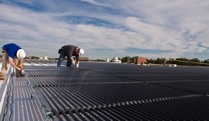Solyndra joins growing number of solar companies filing for bankruptcy
 Solyndra, on Aug. 31, said it would file for Chapter 11 bankruptcy protection. The company had been beleaguered by a number of hindrances, including bringing manufacturing costs down while increasing production to achieve economies of scale.
Solyndra, on Aug. 31, said it would file for Chapter 11 bankruptcy protection. The company had been beleaguered by a number of hindrances, including bringing manufacturing costs down while increasing production to achieve economies of scale.
It’s the third U.S. based photovoltaic manufacturer in as many weeks to do so.
“Global economic and solar industry market conditions have forced the company to suspend its manufacturing operations,” Solyndra said in a press release. “Despite strong growth in the first half of 2011 and traction in North America with a number of orders for very large commercial rooftops, Solyndra could not achieve full-scale operations rapidly enough to compete in the near term with the resources of larger foreign manufacturers. As a result of the suspension of operations approximately 1,100 full-time and temporary employees are being laid off effective immediately.”
Among those commercial rooftops was the solar installation at Qwest Field’s event center adjacent to the Seattle Seahawks’ stadium.
“This competitive challenge was exacerbated by a global oversupply of solar panels and a severe compression of prices that in part resulted from uncertainty in governmental incentive programs in Europe and the decline in credit markets that finance solar systems,” Solyndra said.
In the past two weeks Evergreen Solar and SpectraWatt filed for bankruptcy protection as well. The moves come following a second quarter that was difficult for many photovoltaic manufacturers. The other companies said similar things.
Solyndra had tried to attract investors last year with an initial public offering (IPO) but cancelled it, signaling trouble even then.
“I think the high [capital expenditure] cost of Solyndra, and its marginal performance in the field allowed many to question the viability of the product and company,” said Jeffries and Co. Inc. Equity Analyst Jessie Pichel. “We often referred to it as an expensive bird perch—birds like to hang out on the solar tubes, which is OK, except birds tend to make the solar tubes dirty, which lowers power output.”
The fact that Solyndra is another thin-film company to file for bankruptcy is emblematic of issues that other thin-film technologies are facing as they struggle to bring their technology to market.
“Few thin film companies have been able to demonstrate a lower cost than standard polysilicon panels. Either the [capital expenditure] is too expensive, or cash cost is too expensive,” Pichel said.
Analysts like Pichel and JP Morgan analyst Christopher Blansett anticipate that more solar companies will file for bankruptcy.
“More will go under. However, this is a healthy process of weeding out,” Pichel said. “The ones with the best roadmaps will secure funding and potentially thrive. We think Miasole, Abound [Solar], and Solar Frontier offer the promise of keeping pace with polysilicon modules, but there are a host of other companies that are not well positioned.”
The most established thin-film company in the world is First Solar (NASDAQ: FSLR), which despite a weak second quarter, shows little signs of slowing down.
But Pichel said most of First Solar’s money is now coming through developing projects and not just the sale of its modules.
A Solyndra spokesperson did not return calls for comment.
Image courtesy of Solyndra.



